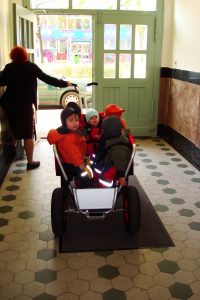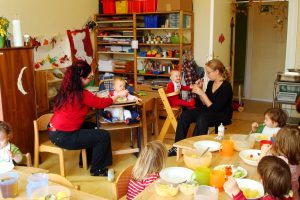Germany
Parenthood and employment
A married couple with one or two children – that is the average German family. But family models are becoming more diverse. There is a high proportion of single parents, patchwork families with children from the parents’ previous partnerships, and rainbow families with same-sex couples. On the other hand, large families with several generations under one roof have become rare. (www.deutschland.de)
The main concern of the Federal Republic of Germany is to find ways to reconcile work and family life. Family policy issues at the national level are addressed by –the Ministry of Family Affairs, Senior Citizens, Women and Youth. (BMFSJ- Bundesministerium für Familie, Senioren, Frauen und Jugend)
Policy-makers have been trying to make it easier for women and men to reconcile their work and family-life. Since 2013 in Germany, all children aged 1 and over have a legal right to education, early learning and care at a day nursery/preschool or with a childminder. Germany’s federal states have invested heavily in the expansion of childcare for infants and school children.
Germany had female employment rate well above the OECD average in 2016, with 70,2% of women between 16-64 in employment compared to an average of 59,1%.
Although 70% of mothers and 6% of fathers work part time, in part-time employment there were differences between mothers in East and West Germany: while in the east in 2017, 49% of mothers with underage children worked part-time, the proportion in the West was 74%. (www.destatis.de)
15% of fathers who worked part-time in 2016 reported childcare as a reason for reducing their working time. The generation of young fathers would like to spend more time with their children and be more involved in their upbringing. Currently, as many as 1 in 3 takes advantage of the parental allowance for two to three months. (www.destatis.de)
Maternity/parental leave and benefits
Maternity leave – Mutterschaftsgeld
In Germany maternity leave is 14 weeks. Maternity periods usually begin 6 weeks before birth and usually end 8 weeks after birth. Maternity benefits are 100% of the average salary of the last three calendar months before pregnancy. The maternity pay is considered normal salary and taxes and social security contributions are paid accordingly.
Parental leave – Elternzeit
Parental leave is 14 months of flexible time that can be split between both parents. The most common strategy is 12 months of parental leave for the mother and 2 more months for the father, but there exist many different splits that can be used.
The possibility how to extend parental leave is an early return to work part-time. In cases when both parents work part-time in the 4 months following there exists special opportunity to take a “Partnerschaft bonus” which means 4 more months of parental leave for both of the parents. When the mother starts to work earlier – during the child’s first year, parents can ask for Elterngeld Plus which adds 12 more months of parental leave.
- Basic parental allowance (Elterngeld) – if both mother and father choose parenting and the mother will not work at all during parental leave, 12 months + 2 months “partner months” (total 14 months)
- Parental allowance Plus (Elterngeld Plus) – if both parents choose a minimum of 2 months of parental leave and both have a part-time job, 24 months
- Partnership bonus allowance (Partnerschaft bonus) – if both parents take 4 months together of parental leave and work part-time, 24 months + 4 months
When the parents decide to take parental leave supported by parental allowance they can work between 20-30 hours per week.
The amount of parental allowance depends on many factors: What kind of parentel benefits you choose Basic parental benefit (Elterngeld) or Parental allowance Plus (Elterngeld plus), how much the income was before pregnancy, if it is the first or second child or in the case of twins or multiple births.
As a Basic parental benefit, you will normally receive 65-68% of the net income you had before birth, which is lost after birth. That means Average Basic parental benefit is between 300 and 1,800 euros monthly and the maximum of Basic parental allowance is 1,800 euros. Elterngeld Plus between 150 and 900 euros per month.
Child benefit – Kindergeld
The child allowance ensures the basic care of your children from birth until at least their 18th birthday. The child benefit especially benefits families with small and medium income.
From 1 July 2019, the child benefit will increase by 10 euros. It will then be for the first and second child: 204 euros per month, for the third child: 210 euros per month, for the fourth and each additional child: 235 euros per month.
You can get child benefit until your child is 18 years old or until age 25 if your child is studying or otherwise training for a profession, or completing a recognized voluntary service.

Childcare provision
More than 10 years ago Federal Ministry of Family Affairs, Senior Citizens, Women and Youth introduced their first „Aktions programm Kindertagespflege“ focused on the care of children under age three. The main goal of this program was to improve the availability of quality childcare for children under the age of three by non-parental persons all over the Germany. In that time the availability of care for children under the age of three was approximately 20% for Germany as a whole. In 2017 this number has increased to 33,6 %.
The main focus was to expand childcare services both at an institutional level – support for the construction of new childcare facilities for children under the age of three, as well as support for non-institutional forms of childcare for children up to three years of age by a qualified caregiver, the so-called Tagesmutter – childminder.
Institutional and non-institutional childcare in Germany
Non-institutional childcare is called Kindertagespflege. Kindertagespflege in Germany is one of the legally recognized forms of childcare in an emerging family environment, a so-called family day care. German legislation mainly supports Kindertagespflege until the age of three. For this age period, it is equivalent to day care facilities and crèches or kindergarten and the choice of type of care depends solely on parents’ preferences.
Among the most popular forms of non-institutional care for children under the age of three is the „Tagesmutter“ or „Tagesvater“ – a nanny who cares for a smaller number of children, up to five children, in their own home.
The permission to become a Tagesmutter is granted by the local Youth Welfare office – Jugendamt.
The YouthWelfare Office considers the suitability of the Tagesmütter / -väter and pays them – if the relevant conditions are met – the financial performance of their services. The office is in charge of expert advice and guidance, as well as upgrading qualifications by e.g. in-service training courses.
It is also possible to open a “Grosstagepflegestelle” (daycare center). In these daycare centers several Tagesmütter (nannies) work together. The performance of these daycare centers is monitored by the Youth Welfare office, which also monitors the quality of care provided. The conditions and requirements for opening and running this kind of daycare center are different in the individual parts/states of Germany.
This form of childcare is most often used for children aged between 1 and 3 years. However, it can also be used for children under 1 or older. However, it is recommended that children start going to kindergartens between ages 3 and 4.
Institutional childcare in Germany is provided by Kinderladen, Kindergarten or Kindertagesstätte, better known as a Kita.
Preschools in Germany are not strictly divided into childcare facilities under the age of three and childcare facilities for those older than three. Children under the age of three are most often integrated into one of the type of preschool facilities. It means that a Kita or Kindergarten can also accept children younger than three. Kindergarten mostly accept children between 3-6 years.
Kids younger than three can be cared for in special groups called Krabellgroupe – toddler groups but they can also be mixed into groups with older children. The only day care facility designed exclusively for children under the age of three is the Kinderkrippe – a children’s crèche, which was prevalent mainly in East Germany. However, these facilities are currently in decline in Germany.
In 2018 there was: 3.6 million children in Kitas
56,000 Kitas in Germany
93% children aged 3-5 in Kitas and
33.6% children aged 0-3

Qualification of nurses/childcare professionals
Minimum qualification for childminders – Tagesmutter or Tagesvater
In case they don’t have any of social-pedagogical education, Tagesmütter or Tagesväter need to complete a Childcare training course lasting at least 160 hours. This kind of training is offered mostly by local educational institutions and it should be based on the educational Qualification curriculum in non-institutional childcare (Qualifizierungshandbuch Kindertagespflege –QHB).
Qualification for childcare professionals
Childcare for children aged 0-6 is provided by the social-pedagogical staff within the pre-school facility. Medical training is not required. A socio-pedagogical education can be obtained at several levels. First at secondary level as part of an upper secondary education (ISCED 3B), or at a post-secondary level (ISCED 4A), or finally as the first stage of tertiary education (ISCED 5A/B).
Among the social-pedagogical professions it is possible to include:
- Soialpädagogische Assistentin , Kinderpflegerin – Social pedagogic assistant, a childminder. The training as a socio-pedagogical assistant or as a nanny is a regulated education at Berufsfachschulen and Berufskollegs Depending on the federal state. The training lasts for two years and includes internships in day care facilities, children’s hospitals or youth facilities.
- (Staatlich anerkannte) Erzieherin – This is the most common profession in institutional childcare. 70% of staff have only this level of education. It takes 2-3 years of theoretical studies at a Fachschule or Fachakademie and 1 year of internship in different childcare facilities.
- Sozialpädagogin/ Pädagogin – Certified social pedagogue or a Certified pedagogue. Social pedagogues (diploma, bachelor, master) or pedagogues (diploma, bachelor, master) have completed at least a three-year (university) or four-year (university) study with a different emphases. In addition to the studies, a minimum of half a year internship is compulsory.
- Kindheitspädagogin – Childhood educators (Bachelor, Master) have completed at least three years (Bachelor) or five years (Master) of childhood education.
- Heilerziehungspflegerin – Special needs educators are trained in pedagogical and early development care for children with physical, mental or emotional disabilities. They have completed a two-year school education and then a practical year of recognition. Some federal states also offer training in a practical three-year form: here the lessons in the Fachkolleg and the practical training in the internship alternate.
Despite the fact that the education of preschool educators and childminders is generally at a post-secondary level, there is long term practice in childcare facilities.
Of course, all these professions can also be held by men. In Germany there is around 5.3% (2017) of men working with preschool children. To get more men working in this field it must be made a priority in state policy.

Many thanks to Barbora Ouřadová for writing this article and sharing the knowledge and experience from her Berlin stay!



